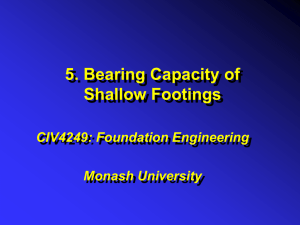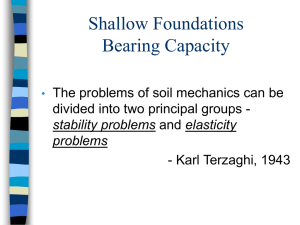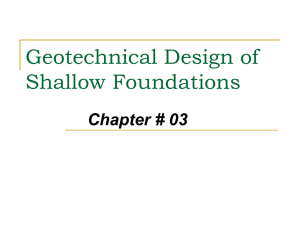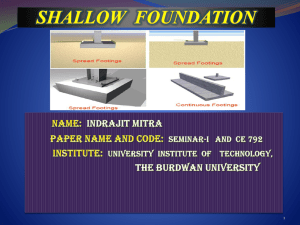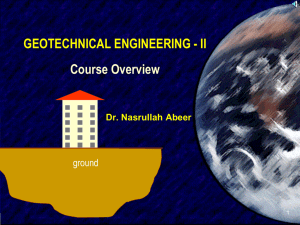File
advertisement
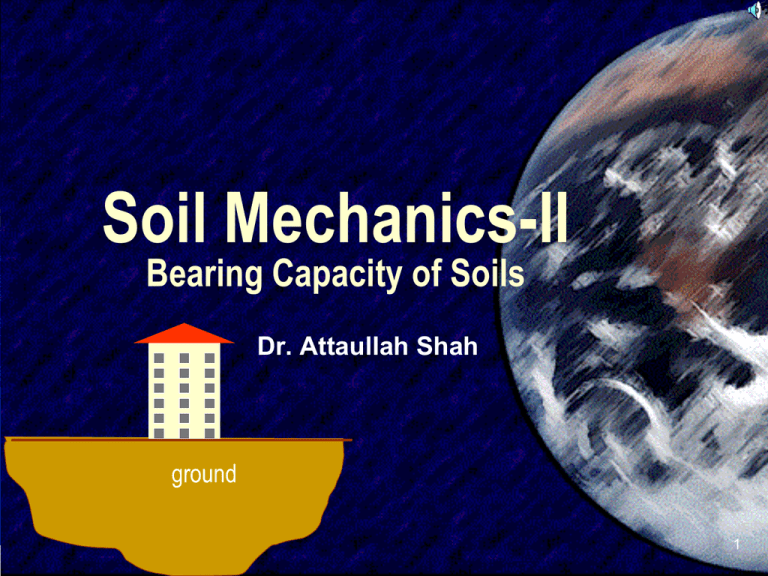
Soil Mechanics-II Bearing Capacity of Soils Dr. Attaullah Shah ground 1 SIVA Selection of Foundation . Shallow foundations: Where the ratio of embedment depth to min plan dimension is less or equal to 2.5 Embedment depth is the depth below the ground surface where the base of foundation rests. a. plain concrete foundation, b. stepped reinforced concrete foundation, c. reinforced concrete rectangular foundation, d. reinforced concrete wall foundation. 2 Steps in selection of Foundation types 1 Obtain the required information concerning the nature of the superstructure and the loads to be transmitted to the foundation. 2. Obtain the subsurface soil conditions. 3. Explore the possibility of constructing any one of the types of foundation under the existing conditions by taking into account (i) the bearing capacity of the soil to carry the required load, and (ii) the adverse effects on the structure due to differential settlements. Eliminate in this way, the unsuitable types. 4. Once one or two types of foundation are selected on the basis of preliminary studies, make more detailed studies. These studies may require more accurate determination of loads, subsurface conditions and footing sizes. It may also be necessary to make more refined estimates of settlement in order to predict the behavior of the structure. 5. Estimate the cost of each of the promising types of foundation, and choose the type that represents the most acceptable compromise between performance and cost. 3 Some basic definitions: Total Overburden Pressure q0 qo is the intensity of total overburden pressure due to the weight of both soil and water at the base level of the foundation. Effective Overburden Pressure q'0 q'0 is the effective overburden pressure at the base level of the foundation. The Ultimate Bearing Capacity of Soil, qu qu is the maximum bearing capacity of soil at which the soil fails by shear. The Net Ultimate Bearing Capacity, qnu qnu is the bearing capacity in excess of the effective overburden pressure q'0 expressed as 4 Gross Allowable Bearing Pressure, qa is expressed as: where Fs = factor of safety. Net Allowable Bearing Pressure, qna Safe Bearing Pressure, qs qs is defined as the net safe bearing pressure which produces a settlement of the foundation which does not exceed a permissible limit. Note: In the design of foundations, one has to use the least of the two values of qna and qs. 5 BEARING CAPACITY THEORIES The determination of bearing capacity of soil based on the classical earth pressure theory of Rankine (1857) began with Pauker, a Russian military engineer (1889). It was modified by Bell (1915). Pauker's theory was applicable only for sandy soils but the theory of Bell took into account cohesion also. The methods of calculating the ultimate bearing capacity of shallow strip footings by plastic theory developed considerably over the years since Terzaghi (1943). Terzaghi extended the theory of Prandtl (1921). Taylor (1948) extended the equation of Prandtl by taking into account the surcharge e Terzaghi (1943) first proposed a semi-empirical equation for computing the ultimate bearing capacity of strip footings by taking into account cohesion, friction and weight of soil, and replacing the overburden pressure with an equivalent surcharge load at the base level of the 6 foundation effect of the overburden soil at the foundation level. Methods of bearing capacity determination 1. Terzaghi's bearing capacity theory 2. The general bearing capacity equation 3. Field tests TERZAGHI'S BEARING CAPACITY THEORY Terzaghi made the following assumptions for developing an equation for determining qu for a c-ɸ soil. The soil is semi-infinite, homogeneous and isotropic, The problem is two-dimensional, The base of the footing is rough, The failure is by general shear, the load is vertical and symmetrical, The ground surface is horizontal, the overburden pressure at foundation level is equivalent to a surcharge load the principle of superposition is valid, Coulomb's law is strictly valid, that is, 7 Mechanism of Failure The shapes of the failure surfaces under ultimate loading conditions are given in Fig. The zones of plastic equilibrium represented in this figure by the area gedcf may be subdivided into three zones: 1 . Zone I of elastic equilibrium 2. Zones II of radial shear state 3. Zones III of Rankine passive state When load qu per unit area acting on the base of the footing of width B with a rough base is transmitted into the soil, the tendency of the soil located within zone I is to spread but this is counteracted by friction and adhesion between the soil and the base of the footing. Due to the existence of this resistance against lateral spreading, the soil located immediately beneath the base remains permanently in a state of elastic equilibrium, and the soil located within this central Zone I behaves as if it were a part of the footing and sinks with the footing under the superimposed load. 8 The depth of this wedge shaped body of soil abc remains practically unchanged, yet the footing sinks. This process is only conceivable if the soil located just below point c moves vertically downwards. This type of movement requires that the surface of sliding cd (Fig.) through point c should start from a vertical tangent. The boundary be of the zone of radial shear bed (Zone II) is also the surface of sliding. As per the theory of plasticity, the potential surfaces of sliding in an ideal plastic material intersect each other in every point of the zone of plastic equilibrium at an angle (90° - ɸ). Therefore the boundary be must rise at an angle ɸ to the horizontal provided the friction and adhesion between the soil and the base of the footing suffice to prevent a sliding motion at the base. The sinking of Zone I creates two zones of plastic equilibrium, II and III, on either side of the footing. Zone II is the radial shear zone whose remote boundaries bd and af meet the horizontal surface at angles (45° - ɸ/2), whereas Zone III is a passive Rankine zone. The boundaries de and fg of these zones are straight lines and they meet the surface at angles of (45° - ɸ/2). The curved parts cd and cf in Zone II are parts of logarithmic spirals whose centers are located at b and a respectively. 9 Ultimate Bearing Capacity of Soil Strip Footings: Terzaghi developed his bearing capacity equation for strip footings by analyzing the forces acting on the wedge abc in Fig. where Qult = ultimate load per unit length of footing, c = unit cohesion, /the effective unit weight of soil, B = width of footing, D,= depth of foundation, Nc, Nq and Nɣ are the bearing capacity factors. They are functions of the angle of friction ɸ. where Kp = passive earth pressure coefficient 10 Bearing capacity factors of Terzaghi 11 Terzaghi's bearing capacity factors for general shear failure 12 Equations for Square, Circular, and Rectangular Foundations Terzaghi's bearing capacity Eq. has been modified for other types of foundations by introducing the shape factors. The equations are: Square Foundations: Circular Foundations: Rectangular Foundations: Ultimate Bearing Capacity qu in Purely Cohesion-less and Cohesive Soils Under General Shear Failure: For cohesion-less soil (for c = 0) and cohesive soils (for ɸ = 0) as follows. Strip Footing Square Footing: Circular Footing Rectangular Footing 13 EFFECT OF WATER TABLE ON BEARING CAPACITY In case the water table lies at any intermediate depth less than the depth (Df+ B), the bearing capacity equations are affected due to the presence of the water table. Case 1. When the water table lies above the base of the foundation. 14 15 Solved Example: A strip footing of width 3 m is founded at a depth of 2 m below the ground surface in a (c - ɸ) soil having a cohesion c = 30 kN/m2 and angle of shearing resistance ɸ = 35°. The water table is at a depth of 5 m below ground level. The moist weight of soil above the water table is 17.25 kN/m3. Determine (a) the ultimate bearing capacity of the soil, (b) the net bearing capacity, and (c) the net allowable bearing pressure and the load/m for a factor of safety of 3. Use the general shear failure theory of Terzaghi. 16 17 If the water table in Ex. 12.1 rises to the ground level, determine the net safe bearing pressure of the footing. All the other data given in Ex. 12.1 remain the same. Assume the saturated unit weight of the soil ɣsat= 18.5 kN/m3. 18 19 Home Assignment A rectangular footing of size 10 x 20 ft is founded at a depth of 6 ft below the ground surface in a homogeneous cohesionless soil having an angle of shearing resistance ɸ = 35°. The water table is at a great depth. The unit weight of soil 7= 114 lb/ft3. Determine: (1) the net ultimate bearing capacity, (2) the net allowable bearing pressure for Fs = 3, and (3) the allowable load Qa the footing can carry. Use Terzaghi's theory. A rectangular footing of size 10 x 20 ft is founded at a depth of 6 ft below the ground level in a cohesive soil (ɸ = 0) which fails by general shear. Given: ɣsat =114 lb/ft3, c = 945 lb/ft2. The water table is close to the ground surface. Determine qu , qnu and qna by Terzaghi's method, 20 THE GENERAL BEARING CAPACITY EQUATION Meyerhof (1963) presented a general bearing capacity equation which takes into account the shape and the inclination of load. The general form of equation suggested by Meyerhof for bearing capacity is 21 22 23 Validity of the Bearing Capacity Equations There is currently no method of obtaining the ultimate bearing capacity of a foundation other than as an estimate (Bowles, 1996). There has been little experimental verification of any of the methods except by using model footings. Up to a depth of Df~ B the Meyerhof qu is not greatly different from the Terzaghi value (Bowles, 1996). The Terzaghi equations, being the first proposed, have been quite popular with designers. Both the Meyerhof and Hansen methods are widely used. The Vesic method has not been much used. It is a good practice to use at least two methods and compare the computed values of qu. If the two values do not compare well, use a third method. 24 STANDARD PENETRATION TEST The method has been standardized as ASTM D-1586 (1997) with periodic revision since 1958. The method of carrying out this test is as follows: 1. The split spoon sampler is connected to a string of drill rods and is lowered into the bottom of the bore hole which was drilled and cleaned in advance. 2. The sampler is driven into the soil strata to a maximum depth of 18 in by making use of a 140 Ib weight falling freely from a height of 30 in on to an anvil fixed on the top of drill rod. The weight is guided to fall along a guide rod. The weight is raised and allowed to fall by means of a manila rope, one end tied to the weight and the other end passing over a pulley on to a hand operated winch or a motor driven cathead. 3. The number of blows required to penetrate each of the successive 6 in depths is counted to produce a total penetration of 18 in. 4. To avoid seating errors, the blows required for the first 6 in of penetration are not taken into account; those required to increase the penetration from 6 in to 18 in constitute the N-value. The SPT is conducted normally at 2.5 to 5 ft intervals. The intervals may 25 be increased at greater depths if necessary. ULTIMATE BEARING CAPACITY OF FOOTINGS BASED ON SPT VALUES (N] Standard Energy Ratio Res Applicable to N Value The empirical correlations established in the USA between N and soil properties indicate the value of N conforms to certain standard energy ratios. Some suggest 70% (Bowles, 1996) and others 60% (Terzaghi et al., 1996). The relation between Ncor and ɸ established by Peck et al., (1974) is given in a graphical form in Fig. The value of Ncor to be used for getting ɸ is the corrected value for standard energy. The angle ɸ obtained by this method can be used for obtaining the bearing capacity factors, and hence the ultimate bearing capacity of soil. Cohesive Soils Relationship Between Ncor and qu (Unconfined Compressive Strength) Relationships have been developed between Ncor and qu (the undrained compressive strength) for the ɸ = 0 condition. This relationship gives the value of cu for any known value of Ncor. The relationship may be expressed as Eq. where the value of the coefficient & may vary from a minimum of 12 to a26 maximum of 25 27
